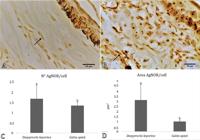ABSTRACT:
Skin and cartilage have been the main source for the recovery of somatic cells to be used in conservation strategies in wild mammals. In this sense, an important step for the cryopreservation of these samples is to recognize the properties of the skin and cartilage. Thus, knowing that the skin may differ among species and aiming to contribute to the establishment of cryobanks, the study examined the differences in the ear skin and cartilage of wild rodents from South America, agouti (Dasyprocta leporina) and spix’s yellow-toothed cavy (Galea spixii). Ultrastructural and quantitative methods were used to measure skin and cartilage thickness, density of collagen and elastic fibers, cell type number and distribution, and proliferative activity. Although ultrastructural analysis revealed a similar pattern between species, morphometric analysis of the skin and cartilage showed differences between agoutis and cavies regarding thickness of epidermis layers (corneum: 5.3±2.5μm vs. 3.9±0.6μm; intermediate: 16.4±6.2μm vs. 23.4±8.1μm; basal: 9.9±2.1μm vs. 4.8±0.5μm), dermis (183.1±44.0μm vs. 258.2±22.9μm), total skin (211.8±46.0μm vs. 290.3±23.7μm) and perichondrium (27.6±6.1μm vs. 10.5±1.8μm). A greater number of epidermal cells (61.7±15.2 vs. 24.8±7.6) and chondrocytes (32.7±9.0 vs. 27.5±4.7) were observed in agouti, while the cavy presented a greater number of melanocytes (12.6±4.7 vs. 29.9±6.2), keratinocytes (14.7±4.2 vs. 29.8±7.6), and fibroblasts (103.6±24.7 vs. 112.2±11.3). Moreover, a higher percentage of collagen fibers and proliferative activity was observed in the skin of cavies, when compared to the skin of agoutis. Therefore, there are differences between agouti and cavy for ear skin and cartilage, requiring the establishment of species-specific cryopreservation protocols.
INDEX TERMS:
Wild rodents; Dasyprocta leporina; Galea spixii; ultrastructure; morphology; morphometry; ear skin; cartilage; cryobanks; wildlife animals

 Thumbnail
Thumbnail
 Thumbnail
Thumbnail
 Thumbnail
Thumbnail
 Thumbnail
Thumbnail
 Thumbnail
Thumbnail




